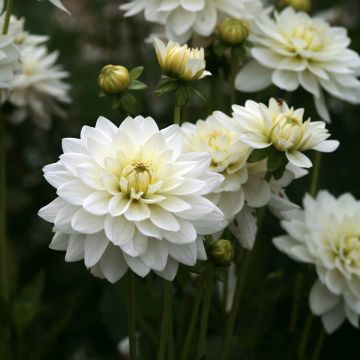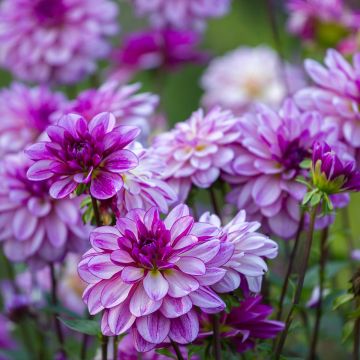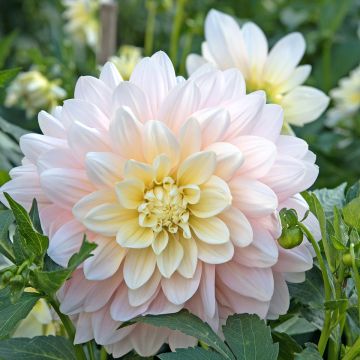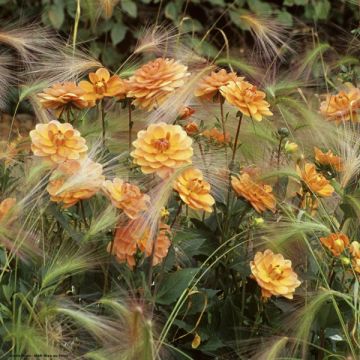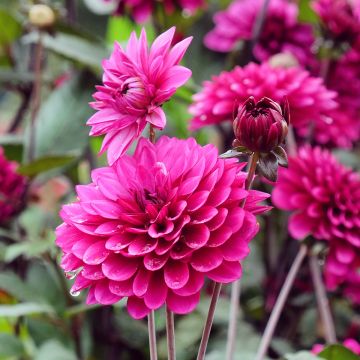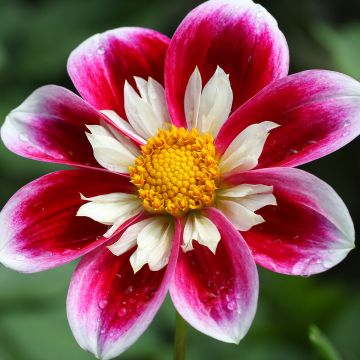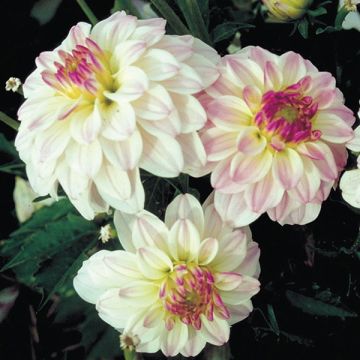

Dahlia camélia Porcelain
Dahlia Porcelain
Dahlia Porcelain
Dahlia
Beautiful delicate and resilient flowers that all visitors to my garden can't stop complimenting.
Loulou , 29/10/2024
Why not try an alternative variety in stock?
View all →This plant carries a 6 months recovery warranty
More information
We guarantee the quality of our plants for a full growing cycle, and will replace at our expense any plant that fails to recover under normal climatic and planting conditions.
From €5.90 for pickup delivery and €6.90 for home delivery
Express home delivery from €8.90.
Does this plant fit my garden?
Set up your Plantfit profile →
Description
The camellia Dahlia 'Porcelain', as delicate as its name suggests, is a variety of dahlia with camellia-like flowers, beautiful flared flowers, white tinged with mauve-violet, lightly dotted with chartreuse in the centre. The plant is quite tall, with rather small, airy flowers, carried by tall sturdy stems. An ideal variety for creating bouquets and scenes full of poetry in the garden, until October-November.
Dahlias are part of the large family of asters, originally from the high plateaus of Mexico. Currently, the thousands of horticultural varieties obtained by humans have invaded, to our great pleasure, gardens all over the world. Dahlia varieties are classified according to the shape of their heads. The 'Porcelain' Dahlia is a decorative dahlia with camellia-like flowers, whose heads are quite flat. They have rows of wide and flared outer ligules. The heads of this 'Porcelain' variety are 12cm (5in) in diameter. The petals are delicately white, slightly tinged with mauve-violet, revealing a centre infused with chartreuse yellow. The flowers last 7 to 12 days in a vase. The plant reaches a height of 1.20m (4ft) and a width of 50 to 60cm (20 to 24in) in just one season. It has a bushy and erect habit, and its leaves are opposite and deeply denticulate. The leaves and stems are dark green. The long and abundant flowering of this variety, if faded flowers are removed, begins in July and ends in October-November.
The 'Porcelain' dahlia is highlighted, in the garden or in a large pot on the terrace, in a pastel atmosphere, emerging from a procession of delicate blue flowers, just as delicate as itself: perennial flax, asters, perennial geranium 'Blue Cloud', Anchusa azurea. The grey foliage of shrubby Artemisias will form a beautiful setting for the whole. It also pairs well with the airy heads of Buenos Aires verbena. You can also wake up this Dahlia with Echinaceas, Cosmos, or even salvias. Some Pennisetums, white Gladioli, or Panicum virgatum 'Dallas Blues' bring softness and delicacy to the decor. The same combinations are successful in homemade bouquets.
Today, an essential in gardens, Dahlias were initially cultivated in Mexico as a root vegetable. Their poor taste qualities quickly assigned them the status of an ornamental plant, but they are still welcome in the vegetable garden to bring a touch of colour among the vegetables.
Report an error about the product description
Dahlia Porcelain in pictures
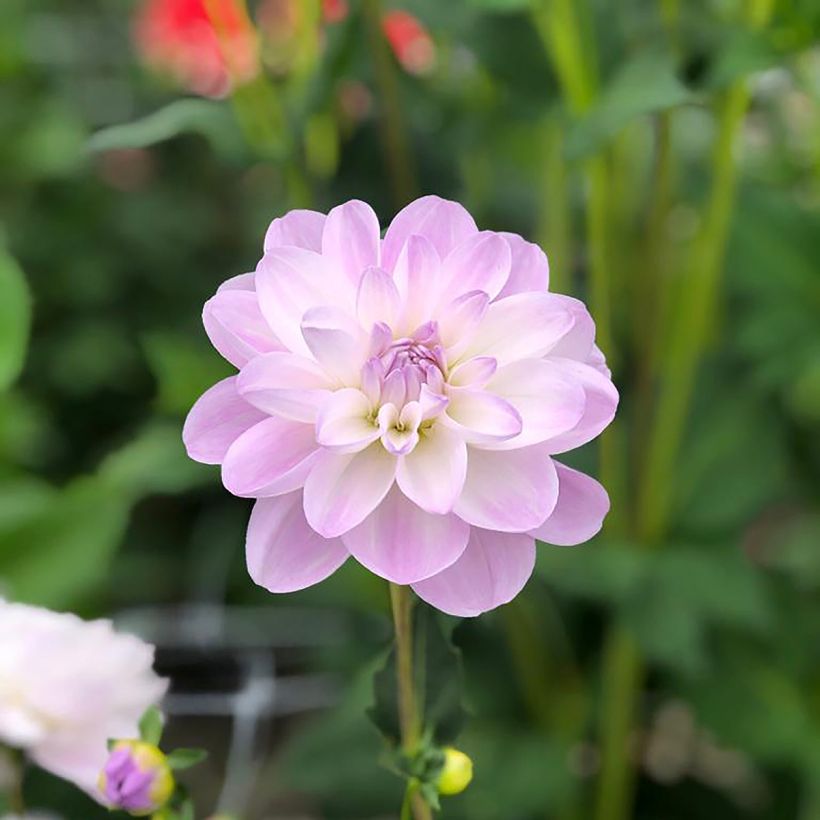

Plant habit
Flowering
Foliage
Botanical data
Dahlia
Porcelain
Asteraceae
Dahlia
Cultivar or hybrid
Other Camellia Dahlia
Planting and care
The 'Porcelain' Dahlia is easy to grow in all regions. For a generous flowering, it is good to follow a few simple rules: plant the tubers in full sun as soon as the last frost has passed, rich, fresh, and well-drained soils are perfect. However, stagnant moisture would promote tuber rot. Do not hesitate to amend the soil with compost and sand if needed. Work the soil deeply and enrich it, for example, with crushed horn or dehydrated blood. Place your tuber and crumble the soil well to fill in without air pockets. Your dahlia should be covered with about 6cm (2in) of soil. At the end of planting, water once abundantly and then regularly renew this watering for the first 6 weeks to help with rooting.
Dahlias are sensitive to cold, so they need to be overwintered. In November, the first frosts blacken the foliage, which is the time to remove them. Carefully dig up the tubers. Remove as much soil as possible. Let the foliage dry so that the tubers can replenish their reserves. Then cut the stems to 10cm (4in). Spread your bulbs in a box on newspaper. Store them in a frost-free, dry, cool, and dark place, such as a garage or attic. In southern regions, close to the coast, where there are only a few days of frost per year, it is possible to leave them in place. In this case, simply cover the ground with a carpet of leaves or straw for protection.
Planting period
Intended location
Care
-
, onOrder confirmed
Reply from on Promesse de fleurs
Dahlias
Haven't found what you were looking for?
Hardiness is the lowest winter temperature a plant can endure without suffering serious damage or even dying. However, hardiness is affected by location (a sheltered area, such as a patio), protection (winter cover) and soil type (hardiness is improved by well-drained soil).

Photo Sharing Terms & Conditions
In order to encourage gardeners to interact and share their experiences, Promesse de fleurs offers various media enabling content to be uploaded onto its Site - in particular via the ‘Photo sharing’ module.
The User agrees to refrain from:
- Posting any content that is illegal, prejudicial, insulting, racist, inciteful to hatred, revisionist, contrary to public decency, that infringes on privacy or on the privacy rights of third parties, in particular the publicity rights of persons and goods, intellectual property rights, or the right to privacy.
- Submitting content on behalf of a third party;
- Impersonate the identity of a third party and/or publish any personal information about a third party;
In general, the User undertakes to refrain from any unethical behaviour.
All Content (in particular text, comments, files, images, photos, videos, creative works, etc.), which may be subject to property or intellectual property rights, image or other private rights, shall remain the property of the User, subject to the limited rights granted by the terms of the licence granted by Promesse de fleurs as stated below. Users are at liberty to publish or not to publish such Content on the Site, notably via the ‘Photo Sharing’ facility, and accept that this Content shall be made public and freely accessible, notably on the Internet.
Users further acknowledge, undertake to have ,and guarantee that they hold all necessary rights and permissions to publish such material on the Site, in particular with regard to the legislation in force pertaining to any privacy, property, intellectual property, image, or contractual rights, or rights of any other nature. By publishing such Content on the Site, Users acknowledge accepting full liability as publishers of the Content within the meaning of the law, and grant Promesse de fleurs, free of charge, an inclusive, worldwide licence for the said Content for the entire duration of its publication, including all reproduction, representation, up/downloading, displaying, performing, transmission, and storage rights.
Users also grant permission for their name to be linked to the Content and accept that this link may not always be made available.
By engaging in posting material, Users consent to their Content becoming automatically accessible on the Internet, in particular on other sites and/or blogs and/or web pages of the Promesse de fleurs site, including in particular social pages and the Promesse de fleurs catalogue.
Users may secure the removal of entrusted content free of charge by issuing a simple request via our contact form.
The flowering period indicated on our website applies to countries and regions located in USDA zone 8 (France, the United Kingdom, Ireland, the Netherlands, etc.)
It will vary according to where you live:
- In zones 9 to 10 (Italy, Spain, Greece, etc.), flowering will occur about 2 to 4 weeks earlier.
- In zones 6 to 7 (Germany, Poland, Slovenia, and lower mountainous regions), flowering will be delayed by 2 to 3 weeks.
- In zone 5 (Central Europe, Scandinavia), blooming will be delayed by 3 to 5 weeks.
In temperate climates, pruning of spring-flowering shrubs (forsythia, spireas, etc.) should be done just after flowering.
Pruning of summer-flowering shrubs (Indian Lilac, Perovskia, etc.) can be done in winter or spring.
In cold regions as well as with frost-sensitive plants, avoid pruning too early when severe frosts may still occur.
The planting period indicated on our website applies to countries and regions located in USDA zone 8 (France, United Kingdom, Ireland, Netherlands).
It will vary according to where you live:
- In Mediterranean zones (Marseille, Madrid, Milan, etc.), autumn and winter are the best planting periods.
- In continental zones (Strasbourg, Munich, Vienna, etc.), delay planting by 2 to 3 weeks in spring and bring it forward by 2 to 4 weeks in autumn.
- In mountainous regions (the Alps, Pyrenees, Carpathians, etc.), it is best to plant in late spring (May-June) or late summer (August-September).
The harvesting period indicated on our website applies to countries and regions in USDA zone 8 (France, England, Ireland, the Netherlands).
In colder areas (Scandinavia, Poland, Austria...) fruit and vegetable harvests are likely to be delayed by 3-4 weeks.
In warmer areas (Italy, Spain, Greece, etc.), harvesting will probably take place earlier, depending on weather conditions.
The sowing periods indicated on our website apply to countries and regions within USDA Zone 8 (France, UK, Ireland, Netherlands).
In colder areas (Scandinavia, Poland, Austria...), delay any outdoor sowing by 3-4 weeks, or sow under glass.
In warmer climes (Italy, Spain, Greece, etc.), bring outdoor sowing forward by a few weeks.


































